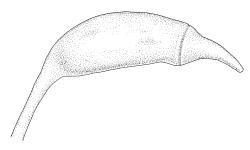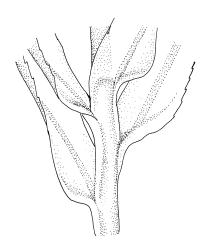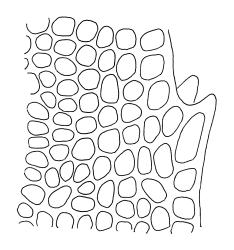- ≡ Rhizogonium mnioides var. contortum Hook.f. & Wilson in Wilson, Bot. Antarct. Voy. III. (Fl. Tasman.) Part II, 216 (1859)
- = Mnium hookeri Müll.Hal., Syn. Musc. Frond. 2, 555 (1851)
- ≡ Rhizogonium hookeri (Müll.Hal.) Mitt., J. Proc. Linn. Soc., Bot. 4: 95 (1859)
- = Mnium mossmanianum Müll.Hal., Bot. Zeitung (Berlin) 9: 547 (1851)
- ≡ Rhizogonium mossmanianum (Müll.Hal.) A.Jaeger, Ber. Thätigk. St. Gallischen Naturwiss. Ges. 1873–1874: 221 (1875)
Plants medium-sized, bright yellow-green to dark green or black (when submerged), forming turves. Stems erect, not or sparsely and irregularly branched, dark brown below, green above, 30–70 mm high, in cross-section five-angled, with c. 4 layers of small, thick-walled cortical cells (the outermost strongly pigmented) gradually merging with parenchyma and surrounding a small central strand, densely beset below with dark brown, much-branched, and smooth rhizoids. Leaves erect-spreading when moist, not complanate, strongly crisped and tubular when dry, symmetric, narrowly lanceolate, weakly auriculate and decurrent at base, bistratose and plane at margins, serrate nearly to base by c. 25–30 pairs of single-celled teeth, (2.0–)3.0–3.9(–4.5) × 0.5–0.8 mm, not conspicuously reduced in size near stem base; upper laminal cells firm walled, irregular in outline (oblong, ± isodiametric or oblate), mostly 0.5–2:1 and 9–15 µm in greater diam., becoming more oblong and/or oblate below and often elongate (to 5:1) and weakly porose near insertion; marginal cells similar in shape, mostly bistratose and adjacent to teeth forming 2 distinct wings (best viewed in cross-section); alar cells not differentiated. Costa concolorous, c. 100–140 µm wide near base and evenly tapered, c. 70 µm wide at mid leaf, subpercurrent, bearing numerous abaxial spines in upper half or more, in cross-section biconvex (more strongly on abaxial surface), with c. 4 median guide cells and abaxial and adaxial stereid bands.
Dioicous. Perichaetia lateral on stem, with leaves slenderly acuminate from an oblong base, to c. 3 mm long (apparently enlarging after fertilisation to c. 5 mm). Perigonia budlike, axillary on lower stem or branches, rarely terminating a lateral branch, with bracts c. 1.5 mm, spreading, costate, acuminate from an obovate, concave, and strongly pigmented base, with numerous antheridia and 5–8 celled filiform paraphyses. Setae 30–50 mm, flexuose, smooth, twisting to the left, orange; capsules horizontal, obovoid from a moderately differentiated neck, asymmetric, 2.0–2.5 mm, smooth, constricted below the mouth when dry, red-brown (darker at mouth); exothecial cells not in longitudinal ranks, irregular (± isodiametric, shortly oblong or oblate), smooth, with uniformly thickened walls, mostly <30 µm in greater diam.; annulus vesicular and persistent; operculum rostrate from a conic base, c. 1 mm. Exostome teeth pale yellow-brown, narrowly lanceolate, inserted c. 50 µm beneath the rim, c. 700 µm long, bordered, outer surface finely papillose (not transversely striate) in lower half, baculate above, inner surface lamellate; endostome with a high membrane; segments ± equal the teeth, keeled, and widely perforate; cilia in groups of 1–3, nodose. Calyptra cucullate, covering the operculum and upper portion of the capsule, c. 3.3 mm. Spores ± spherical, 18–21 µm, pale brown, finely papillose.
Scott & Stone 1976, pl. 56 (as Rhizogonium mnioides); Malcolm & Malcolm 2003, p. 57 (as Pyrrhobryum mnioides); Meagher & Fuhrer 2003, p. 167; Seppelt 2004, fig. 97 (as P. mnioides).
NI: N Auckland, S Auckland, Gisborne, Hawke's Bay, Taranaki, Wellington. SI: Nelson, Marlborough, Canterbury, Westland, Otago, Southland; St; Ch; A; M. Reported from C by Vitt (1974, as Rhizogonium mnioides).
Australasian. Tasmania*, mainland Australia*. The subsp. mnioides is restricted to South America.
On fine or coarse, humic or mineral soil, on rotten logs, tree bases, in lightly to densely shaded forest, subalpine scrub, and occasionally in alpine tussock grassland. It occurs most commonly and is best developed in moist and shaded situations in forest, but also occurs in well-lit habitats. It is often associated with stream margins and when subject to submergence it can be nearly black in colour. Apparently tolerant of a wide range of nutrient availability. It is widespread, frequent, and morphologically variable in N.Z. On North I. from c. 30 (Warawara Forest, N Auckland L.D.) to c. 1200 m (Kaweka Range, Hawke’s Bay L.D.); on South I. from near sea level (Nydia Bay, Marlborough L.D.) to at least 1340 m (Lake Peel and Mt Owen Range, Nelson L.D).
The single published record of P. mnioides from the Kermadecs (Sykes 1977, p. 58) is based on a misidentification of P. paramattense and it was excluded from the flora of that archipelago by both Beever et al. (1996) and by de Lange & Beever (2015).
Paradoxically, perigonia in this dioicous species are difficult to locate despite the common occurrence of capsules. The perigonia are axillary on the lower portion of stems and branches, often partially obscured by rhizoids. Occasionally they occur on rather short (5–10 mm) lateral branches. Scott & Stone (1976, p. 314) quoted from an unknown source that the perigonia (which Scott & Stone had not seen) were "terminal at the apex of main stems", but this is not the usual position.
The type of Hypnum spiniforme var. β Hook.f. & Wilson from the Auckland Islands has not been seen.












